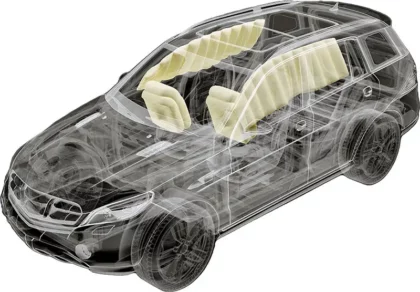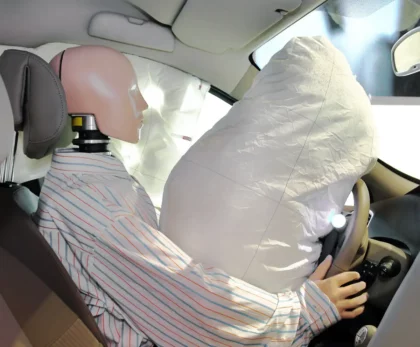Table of Contents
Several safety innovations developed over the last fifty years have saved lives and reduced the rate of car accidents. One safety innovation that has had a profound impact on automobile safety is the airbag. During a car accident, airbags provide protection from the impact of plastic, metal, and glass. That said, people often sustain serious injuries in car accidents even when the airbags deploy. If you have suffered injuries in a car accident, call us at (888) 488-1391 to speak with a California car accident lawyer.
Airbags are often hidden behind the steering wheel or in the passenger compartment, but they deploy instantly in the event of a traffic collision. Since 1999, all passenger vehicles have been equipped with airbags to protect drivers and passengers. Although manufacturers are not required to install side airbags in automobiles, the majority of companies provide them to comply with federal regulations regarding side-impact safety. Side airbags and front airbags can help prevent serious bodily injury and death.
Airbags installed in the front of an automobile’s interior may lower death rates in traffic collisions by approximately 29 percent. The same types of airbags may decrease passenger fatalities for individuals thirteen years or older by roughly 32 percent. Side airbags often prevent drivers and passengers from suffering traumatic brain injuries.
The side airbags that reduce injuries to the head can lower fatalities in car accidents by approximately 37 percent. This number rises to 52 percent for drivers who are in accidents while driving SUVs. Research and development departments at major automobile manufacturers continue to discover novel airbag designs.
Individuals who are located in the backseat are often at risk of suffering injuries during accidents. Rear airbags are one device that manufacturers can install in automobiles to protect rear passengers. Drivers and passengers sometimes collide with one another during accidents, and far-side airbags prevent these collisions from happening. Also, rear passengers often suffer severe chest contusions and lacerations. Inflatable seat belts provide greater protection to all passengers.
Front Airbags & Side Airbags: How They Work
Airbags feature a soft material that supports individual drivers and passengers involved in a car accident. These devices are installed inside automobiles to reduce the likelihood of drivers and passengers striking hard surfaces inside the vehicle. Also, airbags can protect individuals from striking other structures outside the automobile.
From the moment a traffic collision occurs, electronic triggers analyze the degree of force caused by an impact. Once a specific degree of force is reached, these electronic triggers cause airbags to inflate with gas.
Regular maintenance of airbags is not necessary. However, if you are involved in a car accident, it is essential to take your automobile to a mechanic capable of installing new airbags using original equipment manufacturer replacement components. Improper installation of the wrong airbag can endanger drivers and passengers.
Front Airbags
Federal law mandates that automobile manufacturers place passenger and driver airbags in vans, trucks, and cars from the 1999 model year onward. Many drivers and passengers suffer serious bodily injuries during car accidents when their heads and chests strike solid objects inside an automobile.
Drivers and passengers who are sitting upright and wearing seat belts may benefit from airbags. But airbags are also designed to protect everyone inside a vehicle. More recent airbags feature electronic devices that utilize mathematical calculations to trigger deployment during a car accident. Still, the majority of these airbags deploy whether or not the drivers and passengers are wearing safety belts.
Generally, front airbags are triggered for the driver and passengers when the force of the impact equals the amount of force a collision with a brick wall would create. Many airbags are triggered when an automobile reaches approximately 16 miles per hour, when the driver and passengers are not wearing seat belts. Electronic sensors regulate the triggering of airbags in various types of automobiles.
Airbags will be triggered by side collisions as long as the automobile is in motion. Front airbags are located in the steering apparatus and the passenger compartment.
Knee Airbags
A subgroup of automobile designers implements knee airbags in their vehicles. These safety devices are located lower than typical airbags. The primary design objective behind knee airbags is to prevent injuries to the lower extremities. These airbags may also reduce the pressure applied to a driver’s stomach and chest by limiting movement in the legs, thighs, and feet.
Side Airbags
Side airbags can help prevent traumatic brain injuries during car accidents. Side impact accidents often injure a passenger’s chest, head, and neck. Side airbags deploy to provide a cushion between occupants and hard surfaces, which can lessen the severity of these injuries. Also, side airbags prevent drivers and passengers from striking an object outside the vehicle. Providing greater protection, these airbags reduce the impact and distribute the force of impact, thereby reducing the likelihood of serious bodily injury.
Side airbags that provide extra protection for the driver’s or passenger’s head are extremely important. Many of the sharp surfaces and objects inside an automobile are capable of causing a traumatic brain injury. These airbags can prevent glass from lacerating a driver’s or passenger’s body.
It is necessary that side airbags trigger instantly when a side-impact collision occurs. Some vehicles have triggering mechanisms that deploy airbags when the vehicle is traveling at 8 miles per hour upon impact. Other automobiles may not deploy side airbags until the vehicle reaches 18 miles per hour upon impact. Direct collisions also often cause vehicles to deploy airbags.
Federal law dictates specific requirements for torso and head protection for drivers and passengers in automobiles. These protections are generally met by installing side airbags, although side airbags are not required in automobiles. Up through 2014, nearly every new automobile must satisfy these federal regulations. Hence, modern vehicles are typically equipped with side airbag deployment systems.
Crash Tests Featuring Side Curtain Airbags
A protective barrier airbag is the only item situated between an automobile and the crash test dummy’s head.
The Kinds Of Side Airbag Systems
The following are the different kinds of side airbag systems:
- Combination Airbags — These airbags are located in the seats of the vehicle and protect the driver’s chest and neck.
- Head-Protecting Curtain Airbags — These airbags deploy from the roof of the automobile.
- Seat-Mounted Torso-Protecting Airbags — These airbags deploy from the seats and protect the driver’s chest.
- Head-Torso-Pelvis Airbag — These airbags protect the driver’s entire upper body and pelvis.
- Door & Seat-Mounted Airbags — These airbags deploy from the doors and seats inside the vehicle.
- Head-Protecting Curtain Airbags — These airbags deploy from the doors and seats inside the vehicle.
Rollover Deployment Of Side Airbags
Side airbags are supposed to deploy during rollover accidents. Triggers determine if the automobile is moving from side to side. Also, if the vehicle’s weight shifts too far to one side, the airbag triggers can deploy. The airbags inflate almost instantaneously during a rollover accident. Side airbags may also contain gas longer than side curtain airbags. The longer period is designed to prevent injuries if the vehicle turns over more than once. During a rollover accident, the side airbags fill the window space to help restrain drivers and passengers within the vehicle.
Federal regulations do not require the installation of side airbags in all vehicles. Manufacturers, however, use side airbags to comply with regulatory mandates that apply to every vehicle made after 2018. Car accident lawyers can refer to various statutes when assessing cases involving failed airbag deployments.
Airbags During Rollover Accidents
Side curtain airbags are designed to help reduce the risk of ejection during rollover accidents by creating a barrier between occupants and the window opening.
Saving Lives With Airbags
The National Highway Traffic Safety Administration analyzed crash data and suggested that approximately 50,000 people survived dangerous traffic accidents due to the use of front airbags.
Frontal airbags lower vehicle occupant deaths by approximately 29 percent. Deaths of passengers older than thirteen years of age were reduced by roughly 32 percent. The National Highway Traffic Safety Administration suggests that seat belts and airbags both reduce fatalities in frontal traffic accidents by approximately 61 percent. This figure drops to 50 percent if seat belts are used without airbags. Additionally, the figure drops to 34 percent if airbags are used without seat belts. As of 2012, nearly 2,200 people have survived dangerous traffic accidents due to the use of side airbags.
Side airbags that feature upper body safety mechanisms lower a vehicle occupant’s chance of dying in side crashes by approximately 37 percent. The figure for SUVs is 52 percent.
One research team analyzed car accident data from Australia. The team discovered several facts regarding side airbags. Installing side airbags that featured chest and head safety mechanisms inside automobiles lowered an operator’s risk of serious bodily injury or death by approximately 41 percent. Nearly identical data were analyzed in a research analysis centered on the death rate of drivers and passengers who were involved in nearside car accidents.
Torso airbags and curtain airbags used in tandem lowered the death rate by approximately 31 percent. Head and chest airbags lowered the risk of death by approximately 25 percent. These lowered death rates were less common in automobiles that only contained a curtain airbag or a chest airbag.
Crash tests demonstrate that airbags designed to protect an occupant’s head are essential to vehicle safety. The research study started conducting tests in 2003, and more side airbags designed to prevent traumatic brain injuries have been added to vehicles. But airbags will not protect every occupant from every possible injury. During car accidents, drivers and passengers need protection from objects that can enter the vehicle and cause serious bodily injury. Among various safety features, side airbags provide protection from objects that may enter the vehicle during an accident. Nevertheless, if you sustain injuries due to a failed deployment of these safety features, airbag attorneys can evaluate your case and determine who is potentially liable.
Airbag Injuries
It sometimes happens that inflating airbags injure vehicle occupants during deployment. Also, occupants may suffer injury by being thrown close to an airbag before it deploys. The first airbags used in automobiles deployed with more force than more recent airbags that feature safer and more efficient designs.
The National Highway Traffic Safety Administration stated that approximately 290 drivers and passengers died from airbag deployment during car accidents from 1990 to 2008. Approximately ninety percent of fatalities occurred in automobiles created prior to 1998. Also, approximately eighty percent of individuals who died were not wearing seat belts or were wearing them incorrectly. The majority of deaths were not drivers but passengers, and approximately ninety percent of the deaths were babies and children. These children did not wear seat belts or were situated too close to the airbag due to their placement in a child safety seat.
Many senior citizen drivers and short drivers often sit close to the steering wheel and steering column and suffer injuries during airbag deployment. Many federal mandates require that automobiles be designed to prevent the risk of serious bodily injury and death. In the current era of automobile and airbag design, injuries caused by airbags are the exception and not the norm.
Many regulatory alterations occurred in two separate parts. First, federal laws and regulations were changed to pressure automobile manufacturers to lower the amount of energy released in frontal airbags. This process first occurred in automobiles manufactured in 1998. The next big change came in 2007. The National Highway Traffic Safety Administration created an airbag regulation requiring specific airbags in all automobiles manufactured in 2007 and later.
Newer airbag designs alter how the airbag deploys depending on readings analyzed by weight sensors inside the car seats. These sensors can detect if a driver is tall or short. Every automobile manufacturer has to complete a set of examinations with variously sized crash test dummies. These dummies wear seat belts during some tests and do not wear seat belts during other tests. These tests are conducted in different arrangements to test the automobile’s safety.
Side airbags can release significant amounts of energy and cause serious bodily injury. But side airbags are often more compact than frontal airbags. Side airbags also release less energy than frontal airbags. The rate of injuries caused by side airbags is not as well known, but it is commonly assumed that injuries caused by side airbags rarely occur. Research studies involving side accidents and children did not find any increased risk of serious bodily injury to children younger than fifteen years of age.
Airbags can malfunction and injure drivers and passengers. The federal government recalls automobiles containing defective airbag mechanisms that create a greater likelihood of serious bodily injury. Some defective airbag systems may fail to deploy correctly. Often, airbags fail to deploy at the appropriate time or with sufficient force to protect the driver and passengers. Defective airbag systems may also contain damaged parts that cause the entire airbag system to malfunction. Every driver who gets a recall notice regarding airbag systems should replace the airbag system promptly. If you’ve been injured by a malfunctioning product, you can consult defective airbag attorneys for a free case review.
Recall data can be analyzed in the National Highway Traffic Safety Administration recall database. Consumers may also discover information regarding reliable mechanics and vehicle service businesses that can fix recalled automobiles.
The Takata Airbag Recall
The Takata recall is one of the most significant recalls in United States automotive history. Beginning in 2015, approximately seventy million automobiles were recalled by the end of 2019. The issues that caused the issuance of the recall have been linked to approximately fifteen fatalities in the United States. Also, a little more than 250 individuals suffered serious bodily injuries due to faulty mechanisms. If you were injured by a Takata airbag, consider consulting with a California car accident attorney about your legal options. They can assess your situation and determine if you have a valid product liability claim.
How Can Drivers & Passengers Lower The Risk Of Injuries Caused By Airbags?
Passengers and drivers must focus on sitting in the middle of their seat in an upright position with their back straight against the seat. Also, passengers should keep their feet firmly on the floor of the vehicle. Passengers and drivers should not place their arms or hands on an airbag. The energy released during deployment may cause serious bodily injury. Occupants should not place covers on their seats because these can prevent airbags from deploying. Seat covers may also cause an airbag to deploy in the wrong direction.
Drivers should place their chests approximately ten inches from the steering wheel. If a driver is shorter, they should sit back in the seat so that their chest is not extremely close to the steering wheel and steering column. The recently developed airbag systems calculate an occupant’s position on a seat and use less energy to deploy an airbag. Other drivers may need to use tools to extend pedal reach to lower the risk of serious bodily injury or death.
Children should not sit in the front seat of a vehicle. Young children need to sit in the back seat of a vehicle. If a child must sit in the front seat, it is important to place the seat far away from the passenger compartment. Also, a child must be strapped in with a lap and shoulder belt while sitting against the seat.
Young children should be told not to lean on the doors containing side airbags. If an accident occurs, a child may suffer an injury from a deploying airbag. Children who put their heads or other parts of their bodies near doors are at greater risk of suffering serious bodily injury or death during a traffic accident. In such cases, injury attorneys can guide the victims and their families through their possible legal options.
Safety organizations advise that pregnant women use seat belts and airbags to provide protection for themselves and their unborn child. If a driver is pregnant, they should keep their stomach at least ten inches away from the steering column and steering wheel at all times. The seat belt should be placed on the pregnant driver’s thighs beneath the abdomen.
Airbag Innovations
Many designers and automobile manufacturers are discovering improved ways of incorporating safer airbags into vehicles.
Inflatable Safety Belts
Inflatable seat belts began to appear in vehicles in 2011. These devices are intended to improve the safety of both adults and children. In certain crash scenarios, inflatable seat belts may provide enhanced protection for children who are using booster seats or standard seat belts. The shoulder belt will inflate during an accident, and the force of impact will not concentrate in one area of the body but spread across the upper body and the torso.
Many automobiles feature inflatable seat belts as an optional feature. Many luxury automobiles categorize inflatable safety belts as a standard feature.
Ford Inflatable Seat Belt (Ford Motor Company)
Ford inflatable seat belts are designed to provide additional safety features for drivers and passengers.
Far Side Airbags
These types of airbags are also known as front-center airbags. They are designed to help limit front-seat passengers from striking one another during traffic collisions. Turnover accidents and side-impact crashes are common types of accidents, during which passengers are thrown around and may hit each other during the collision. General Motors featured the first front-center airbag in 2013.
Toyota has engineered a system to help protect rear passengers. The airbag system designed by Toyota deploys from the center console in the vehicle’s back seat.
EuroNCAP, in 2020, created a novel collision test to help car manufacturers understand the benefits of far-side airbags. Currently, the Genesis GV80, Genesis G80, Buick Enclave, GMC Acadia, and Chevrolet Traverse all feature far-side airbags.
Panoramic Sunroof Airbag
In the year 2017, the supplier Hyundai Mobis created a panoramic roof curtain airbag. The panoramic roof curtain airbag is designed to reduce the likelihood of a driver or passenger being thrown from the sunroof or moonroof during a rollover accident.
The National Highway Traffic Safety Administration has suggested that approximately two hundred and sixty drivers and passengers were thrown from sunroofs and moonroofs from 2000 to 2015. These issues are predicted to expand as panoramic sunroofs become more commonplace and less expensive.
Designers must face these problems. Engineers often delay including these unique airbag systems in automobiles. The airbag system must function with the sunroof open or closed and fit inside the vehicle without compromising driver visibility or headspace.
Seat Cushion Airbag
Created to lower the amount of force exerted on a driver’s or passenger’s stomach and upper body, seat cushion airbags limit the motion of bodies inside the automobile. The Toyota Yaris features seat cushion airbags.
Rear Seat Airbag
Rear seat airbags protect the heads of passengers sitting in the rear of the vehicle. The rear seat airbags are situated in the back portion of the front seats. These airbags do not use as much release energy as traditional airbags. Rear seat airbags do not fully inflate, which provides added safety to children in car safety seats. The new S-class released by Mercedes-Benz may include rear-seat airbags.
Flexible Seating Airbag Systems
The vehicles currently being developed for release in future years will need to contain new airbag systems that will protect drivers and passengers. The companies that supply airbags are developing new airbag systems that incorporate advanced protection features for passengers. The Autoliv Life Cell and Joyson’s Embrace are two examples of flexible seating airbag systems.
Precrash External Side Airbag System
External side airbags are intended to lower the force during traffic collisions, particularly side collisions. The external side airbags were created by ZF. Precrash triggers focus on future side crash force and release external airbags from beneath the automobile to protect the rear passenger doors and the driver doors. These devices are nearly the size of an inflatable raft. No vehicles come equipped with this type of airbag system.
External Hood Airbag
The initial hood airbag system, intended to protect pedestrians, was created by Volvo. If the sensors detect that a collision with a pedestrian is imminent, the external airbag releases from beneath the vehicle’s hood. The airbag covers the windshield and other areas of the car that commonly cause serious bodily injury to pedestrians. The Volvo V40 features the pedestrian hood airbag. These models are available in Europe and were first available in 2013.
Motorcycle Airbag
Front airbags are available on Honda’s 2006 Gold Wing motorcycle. The feature is also available on later models. The airbag system releases during frontal collisions and reduces the motorcyclist’s forward momentum. As of yet, no researchers have analyzed the efficacy of motorcycle airbags.
Motorcyclist Vest Airbag
Motorcyclists can wear airbags that provide protection during accidents. Vest airbags are manufactured by Helite, HitAir, and AlpineStars Tech Air. The vest airbag systems were created to soften impacts around the motorcyclist’s spinal cord, torso, and neck.
When a motorcyclist is cruising down the highway, a tether attaches the airbag vest to the motorcycle. If an accident occurs, the motorcyclist and the motorcycle separate, and the tether snaps, triggering a carbon dioxide device that inflates the airbag. These carbon dioxide compartments can be replaced.
Bicycle Helmet Airbag
Bicycle helmets were developed by the Swedish company Hovding. A bicycle airbag can serve as an alternative to a traditional bicycle helmet. The airbag comes out of a collar placed around the bicyclist’s neck. Sensors and triggers release the airbag when unfamiliar motion occurs. A bicycle airbag deploys in less than one second.
Call Us Today To Speak With A California Car Accident Lawyer
If you or a loved one suffered an injury during an accident, contact Arash Law. Our personal injury lawyers can help you seek financial compensation for your injuries. We have years of experience representing clients in personal injury cases. Call us at (888) 488-1391 to schedule a free initial consultation or complete our “Do I Have A Case?” form here. We serve clients throughout California, including San Francisco, Riverside, Sacramento, San Jose, Los Angeles, San Diego, Sherman Oaks, and other cities.































